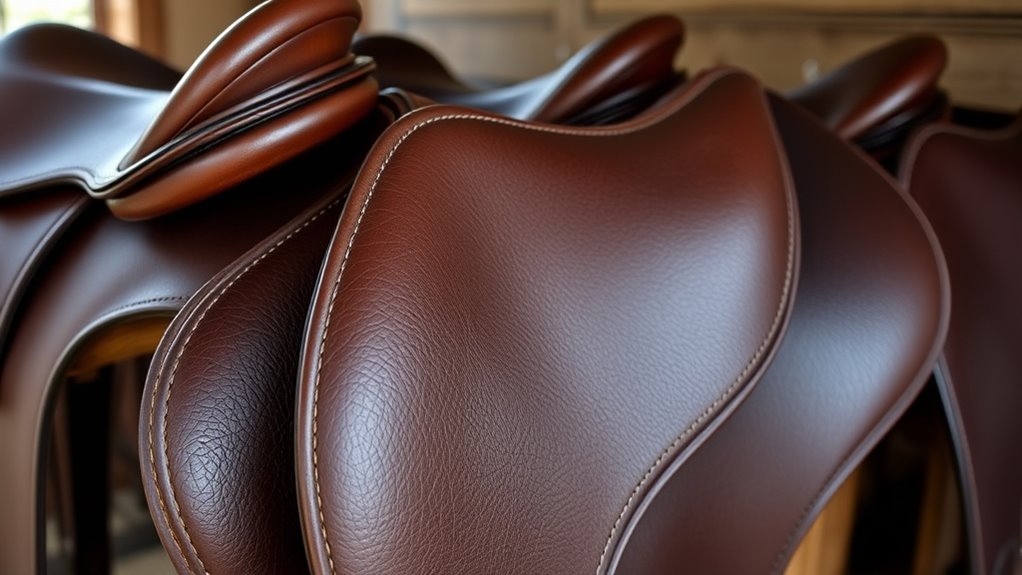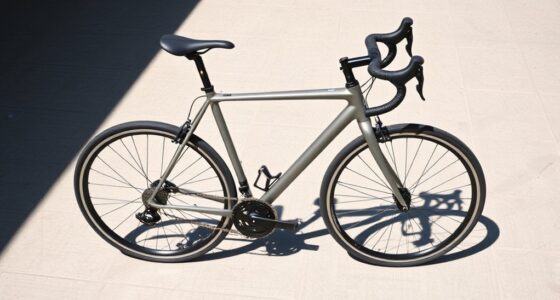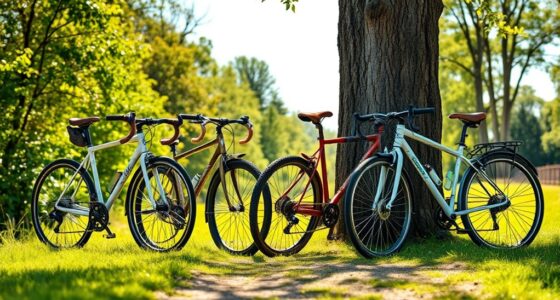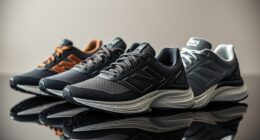To choose the right saddle, understand that shapes and widths are designed to match your sit bone distance and anatomy for ideal support and comfort. A properly fitted saddle evenly distributes pressure, reducing numbness and soreness during long rides. Narrow saddles can cause soft tissue pressure, while wider ones support mobility and prevent chafing. Good pressure relief depends on a saddle’s shape and materials—learn how these work together to boost comfort and performance as you explore further.
Key Takeaways
- Saddle shape and width should match sit bone distance for optimal pressure distribution and comfort.
- Narrow saddles may cause soft tissue pressure and injury, while wider ones support mobility and reduce chafing.
- Proper ergonomic design distributes pressure evenly, supporting long rides and preventing numbness or soreness.
- Materials like high-quality foam or leather conform to the rider’s body, enhancing support and reducing fatigue.
- A well-fitted saddle aligns with the rider’s anatomy, promoting natural posture and minimizing discomfort during extended cycling.
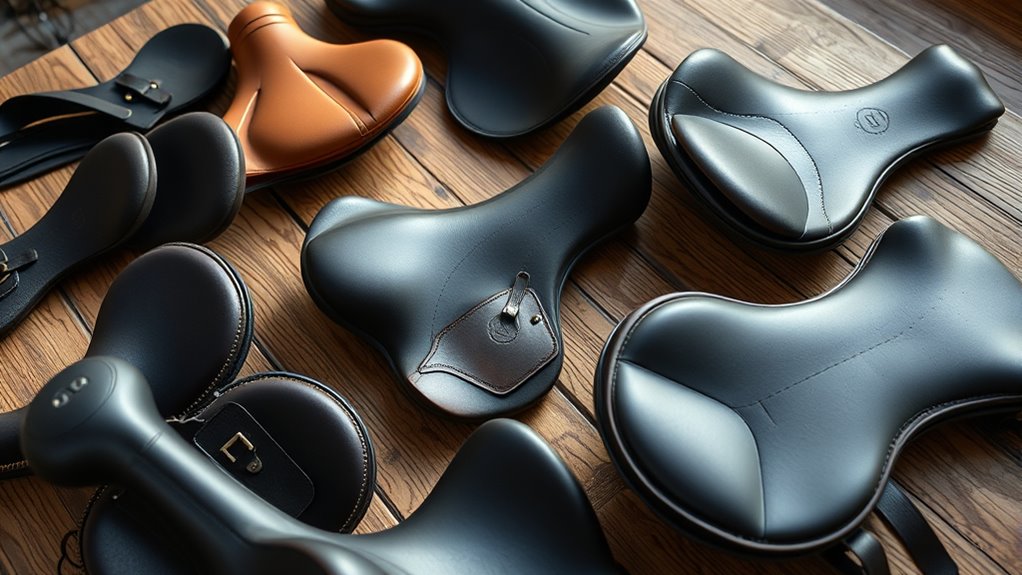
Have you ever wondered what makes a saddle truly comfortable and functional? The answer lies in a combination of thoughtful design, quality materials, and proper fit. When it comes to comfort, the ergonomic design of a saddle plays a vital role. This design considers the rider’s anatomy, ensuring that pressure is evenly distributed and that you maintain a natural, balanced posture. An ergonomic saddle supports your sit bones and reduces pressure points, making long rides more comfortable and less fatiguing. The shape of the saddle also influences how well your weight is supported, helping to prevent numbness or soreness after extended periods in the saddle.
The saddle materials are equally important because they directly affect durability, weight, and comfort. High-quality saddle materials like synthetic fabrics, leather, or advanced foam padding are chosen to optimize comfort without adding unnecessary weight. Leather, for example, molds to your body over time, offering a customized fit, while synthetic options often provide lighter weight and easier maintenance. The padding and cover materials are designed to absorb shocks and vibrations, which helps reduce fatigue and discomfort. When selecting saddle materials, it’s essential to find a balance between softness and firmness; too soft, and the saddle may not provide enough support, too firm, and it may cause pressure points.
A well-made saddle also considers the shape and width to match your anatomy. The width should align with your sit bones to prevent chafing and numbness. If the saddle is too narrow, it can cause pressure on soft tissues, leading to discomfort and even injury over time. Conversely, a saddle that’s too wide may hinder your mobility or cause chafing. Proper alignment of the saddle shape with your anatomy ensures pressure is relieved from sensitive areas and that your pelvis remains in a neutral position. Additionally, the pressure distribution across the saddle’s surface plays a crucial role in long-term comfort, especially during extended rides.
In addition to shape and material, the construction quality influences the overall comfort and longevity of the saddle. Reinforced stitching, quality padding, and a sturdy base all contribute to a saddle that can withstand regular use without losing its supportive properties. When you choose a saddle with ergonomic design features and high-quality materials, you’re investing in comfort, durability, and better riding performance. It’s not just about selecting a saddle that looks good; it’s about ensuring it fits your body and riding style perfectly. With the right combination, your saddle can become an extension of your body, helping you ride longer, more comfortably, and with greater confidence.
Frequently Asked Questions
How Often Should I Replace My Saddle?
You should replace your saddle every 5 to 7 years, depending on saddle maintenance and how often you ride. Regular saddle adjustments can extend its lifespan, but signs like uneven wear, cracks, or decreased comfort mean it’s time for a new one. Keep an eye on your saddle’s condition, and don’t hesitate to replace it when necessary to guarantee ideal support and comfort during rides.
Can Saddle Shape Affect Riding Performance?
Yes, saddle shape can considerably affect your riding performance. A properly shaped saddle supports your anatomy and allows free movement, helping you stay balanced and efficient. If the saddle shape doesn’t match your riding style or body, you might experience discomfort or reduced control, which hampers performance. Choosing a saddle with the right shape enhances comfort and optimizes your skills, making every ride smoother and more effective.
What Materials Are Best for Pressure Relief?
For effective pressure relief, you want materials that conform, cushion, and breathe. Gel padding offers excellent shock absorption and molds to your body, providing comfort during long rides. Foam with high density offers firm support, reducing pressure points and maintaining shape over time. Combining gel padding with dense foam creates a saddle that minimizes discomfort, distributes weight evenly, and enhances your riding experience. Choose materials tailored to your comfort needs and riding style.
How Do I Know if My Saddle Fits Properly?
You can tell if your saddle fits properly by checking for even pressure and comfort. Make sure saddle padding provides enough cushioning without causing pinching. When you first get it, expect a saddle break-in period where it molds to your shape. During rides, monitor for discomfort, pinching, or slipping. A well-fitting saddle supports your position and keeps your horse comfortable, so listen to your body and your horse’s reactions.
Are Custom Saddles Worth the Investment?
Are you willing to invest in a saddle that perfectly matches your riding style and your horse’s needs? Custom saddles are worth it if you value saddle aesthetics and want a tailored fit, reducing discomfort for both of you. While they come at a higher cost, top brand reputation and personalized comfort can enhance your riding experience. If you’re serious about quality and long-term performance, a custom saddle could be a smart choice.
Conclusion
Remember, a well-chosen saddle can make all the difference in your ride. By understanding shapes, widths, and pressure relief, you’re better equipped to find a perfect fit. Don’t settle for discomfort—your bike should feel like an extension of you. As the saying goes, “A smooth sea never made a skilled sailor.” Keep experimenting, stay patient, and soon, you’ll find that sweet spot where comfort and performance meet. Happy riding!
